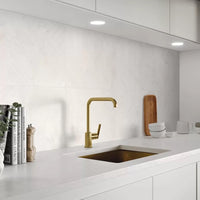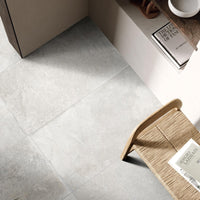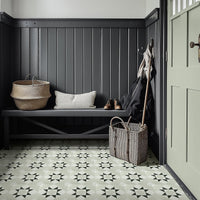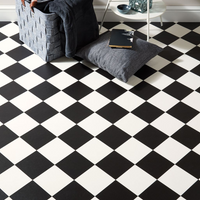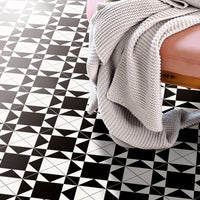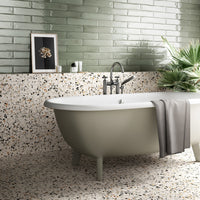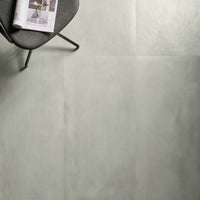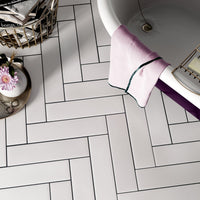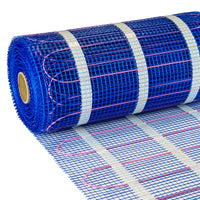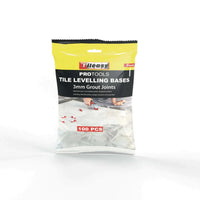Tile trims provide a crisp finish to the edges of any tiled area. They're particularly useful for corners where, without the hard-to-achieve alternative of accurately mitring the tiles themselves, you'll be left with exposed tile edges.
Trims provide an attractive finish to your tiling project
Trims not only provide a perfect and professional finish, but they also cover any sharp edges that could be a hazard, or prone to damage.
Choosing Your Tile Trim
If tiling walls, the first step when using trim is to decide if you'll be installing tile trim to just the base of the wall, or at the corners as well.
When installing trim to floor tiles, you should install trim on all your edges or to the edge where the tile meets another flooring material, often called a transition joint.
There are four main types of tile trim that can be used to finish the perimeter of an installation:
- plastic trim
- metal trim
- ceramic/porcelain trim
- stone trim
Plastic and metal trims are by far the most widely used, and are a favourite of the DIY tiler.
What Finishes Are Available?
Tile trim is available in a variety of plain and patterned finishes, and in metallic options. There's also a wide range of different profiles - some are produced for aesthetic reasons while others are designed for specific functions, such as tiling around a bath’s edge.
A trim with a rounded or bullnose edge can create an additional feature in tiled walls. Available in various colours, such trims can either accent by contrasting with the tiles, or blend in by matching the tiles. If you're looking for something more sleek and contemporary, a popular option is a straight edge trim in chrome.
Here, a metallic trim is used to separate the mosaics from the wall tiles, and provides a feature in itself
To seamlessly connect a three-way join, select a trim with edge corners. Also available in plain colours or metallic finishes, they protect the corner and finish off the joint perfectly.
These gold Tileasy trims add a luxurious finish to the room
Trims also come in a range of different surface finishes to provide still more design options. As noted earlier, when pairing trim with tiles, the best two options are subtle colour matching or stylish contrast.
Pro tip:
For extra sophistication, match the metallic finish of your tile trim to your brassware and taps
What Depth Of Trim Will I Need?
Having paired your trim to the tiles, it is vital to choose the correct size and depth of trim. This means matching the depth of the trim’s recess with the thickness of the tile. This simple step is vital to achieving a professional look.
When measuring up, remember to make allowance for the adhesive layer. In effect, this means selecting a tile trim that is one size up from the thickness of your tile. For example, if your tile is 10mm thick, choose a 12.5mm trim to ensure a crisp finish.
How To Cut Tile Trim
It may be necessary to cut the trim for certain areas of your project. For instance, to achieve a professional finish around a window, create a frame of tile trim that will sit around the lip.
First, you'll need to measure the base and corners to be installed with tile trim to determine how much linear trim you will be need.
Cut the corners at a 45-degree angle so that the pieces of trim will fit exactly together. Place the trim in a mitre block, choose the correct angle, and cut carefully using a hacksaw with a new blade.
Pro tip:
Always double check all your measurements. Remember - measure twice, cut once!
Take great care to mark exactly where the cut needs to be made and always hold the trim firmly against the edge of the mitre block - ideally using a clamp - throughout to ensure a clean cut. Once you’ve made two cuts at opposing angles, offer them against the tile, making sure that the pieces of trim fit together correctly.
If you do not need to mitre the trim, simply cut it at a 90° angle to the exact length required.
How To Bend Tile Trim
When tiling a small area such as a bathroom splashback, you may want to avoid potential sharp edges that can occur when lining up cut metal trim. An alternative is to bend the trim, rather than cut it.
Firstly, cut your trim to size so it is ready to be installed. Measure the trim along the line of one of the exposed sides of the tile and mark where it meets the corner. Then, using some sharp tin snips, cut the trim at two opposing 45-degree angles, effectively creating a V-shaped cut. You can then line up the trim and bend it round the corner of the tile.
Repeat this process at each successive corner to achieve a complete bent trim finish.
How To Install Tile Trim
To install tile trim, firstly mix your adhesive and then apply as normal using an appropriately-sized notched trowel to the area where your trim will be applied.
Push the trim into this bed of the adhesive, making sure that it's held in place. Then, continue to lay your tiles onto the surface, applying adhesive to the back of the tile to ensure a strong bond between tile and trim.
It's important to ensure the trim is fully bedded into adhesive
In areas prone to getting wet - such as a shower niche - make sure that there's a 2mm gap between the trim and the tile edge. This space should then be grouted to minimise the risk of water penetrating between tile and trim.
Follow a similar process to install tile trim around a bath. To ensure a perfect fit, always half fill the bath with water before fixing the trim, in case the bath moves during filling. Seal the gap between the bath and the wall with silicone before fitting the trim.
Summary
• Plan the fitting of your tile trim alongside the installation of your tiles
• Cut the trim at a 45° angle with a hacksaw, and always check the fit before installation
• Mark where the trim will be installed before fitting
• Spread tile adhesive, and then press the trim firmly into it
• Let the adhesive dry overnight
• Grout the spaces around the trim and allow to dry
• Mark where the trim will be installed before fittingIf required, apply a grout sealer
All images supplied by Tileasy
